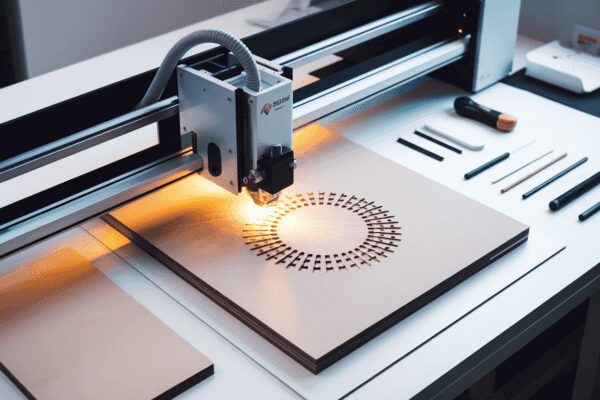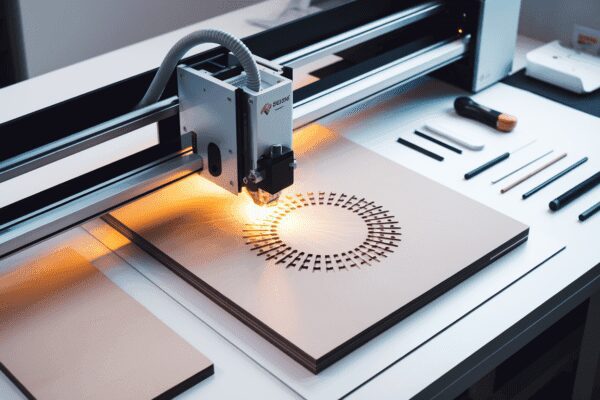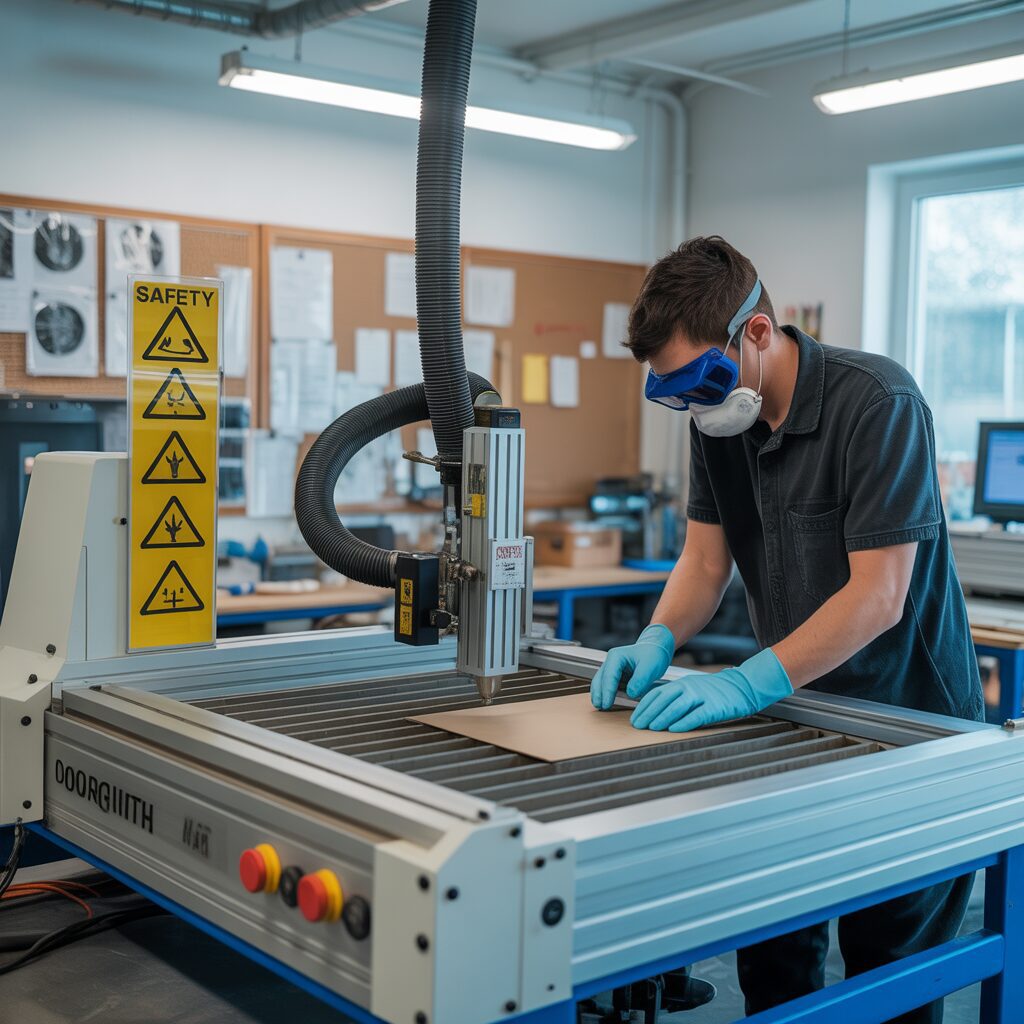Essential Safety Practices for Laser Engraving Workshops
Estimated Reading Time
~9 minutes
Key Takeaways
- Laser engraving introduces significant hazards: including severe eye injuries from highly focused beams, skin burns, and toxic fumes from processed materials like wood, plastics, and metals.
- Personal Protective Equipment (PPE) is crucial: Always use wavelength-specific laser safety glasses , fire-resistant gloves and aprons, and appropriate respirators (N95 or half-face) to mitigate direct and indirect risks.
- Effective ventilation is fundamental: Implement Local Exhaust Ventilation (LEV) with proper filtration (HEPA, activated carbon) and supplement with general air filtration to control airborne contaminants.
- Workspace design enhances safety: Segregate flammable materials, maintain clear emergency exits, and ensure prominent safety signage and readily accessible fire extinguishers.
- Emergency preparedness is non-negotiable: Conduct regular drills, maintain a well-stocked first aid kit, and establish clear, practiced protocols for accidents and evacuations.
Table of Contents
- Recognizing and Managing Laser Engraving Hazards
- Choosing and Using Personal Protective Equipment
- Ventilation, Workspace Design, and Emergency Preparedness
- Conclusions
- Frequently Asked Questions (FAQ)
Laser engraving is a powerful tool for creating precise and intricate designs, but it also introduces serious safety hazards ranging from eye injuries to toxic fumes. In this article, we explore the best practices for maintaining a safe workshop environment while using laser engraving equipment, so you can focus on your craft with peace of mind.
Recognizing and Managing Laser Engraving Hazards
Laser engraving is a powerful and creative process, but it comes with its own unique set of hazards that demand careful attention. Understanding these risks and how to manage them is essential for anyone working in a laser engraving workshop.
Risks of Eye Injuries and Burns from Laser Light
The most immediate danger in laser engraving comes from exposure to the laser beam itself. Unlike ordinary light, laser beams are both highly focused and coherent , meaning the light waves are perfectly aligned and travel together. This coherence enables a laser to maintain extremely high power concentrations over long distances, making the risk of unintended exposure significant even if you are not directly next to the machine. Accidental exposure, even for a fraction of a second, can cause severe eye injuries, including permanent blindness . The retina is particularly vulnerable because it focuses incoming light — including laser light — into a concentrated point, amplifying the damage.
Skin burns are another acute hazard. The laser’s energy, when accidentally directed onto the skin, can cause painful burns almost instantly. Unlike conventional heat sources, the risk is less obvious: there is rarely much warmth or visual clue until the actual injury occurs. Both reflected and scattered laser beams — not just the main beam — can pose danger, underscoring the importance of strict safety protocols around any active laser system.
Why Coherence Makes Lasers Especially Dangerous
The Unique Threat of Coherent Light
Laser light, due to its coherence, does not disperse like light from a traditional bulb. This means even a weak beam can cause tissue damage at a significant distance from the source, especially if focused by the curvature of a lens or reflective surface. Reflections from glossy desks, jewelry, watch faces, or even some anodized metals can redirect hazardous energy unexpectedly. This makes it crucial to assess not just the direct working area, but the environment as a whole to minimize the risk of stray beams.
Fume and Particulate Hazards: The Invisible Risks
Laser engraving isn’t just about the light. The process of using intense energy to cut or engrave materials releases a cocktail of fumes and particulates into the air. The type and severity of emissions depend on the materials being processed:
- Wood: Can release fine dust and volatile organic compounds (VOCs), some of which are known irritants or carcinogens.
- Plastics: Materials like acrylic (PMMA) or polyvinyl chloride (PVC) can emit hazardous fumes. Acrylic may produce irritating methyl methacrylate, while PVC’s decomposition releases highly toxic hydrogen chloride gas and dioxins, which are persistent environmental hazards.
- Metals: While many metals produce less visible smoke, certain coatings or composites can produce hazardous particulate metal oxides or fumes that are harmful when inhaled.
Short-term exposure to these emissions can result in headaches, eye and throat irritation, or respiratory discomfort. Long-term or repeated exposure significantly increases the risk of developing chronic respiratory conditions, allergic sensitization, or even cancer, depending on the substances involved. Even materials that seem harmless, like untreated wood or painted surfaces, can emit unexpected toxins when vaporized.
The Critical Need for Hazard Awareness
Before operating any laser engraving machine, it’s vital for all personnel to be trained in recognizing these risks. Workshops must establish a robust hazard identification process, including consulting material safety data sheets (MSDS) for all substrates, understanding the potential for toxic byproducts, and assessing the workspace for reflective surfaces or ventilation issues. Ignorance or complacency in this area can turn a creative environment into a hazardous one.
Effective management of these hazards goes far beyond common sense or simple caution. It requires a thorough understanding of the unique properties of laser light, the chemical composition of processed materials, and the diverse routes by which harm can occur. This hazard awareness is the foundation upon which safe workshop practices — including the appropriate use of personal protective equipment described in the following chapter — must be built.
Choosing and Using Personal Protective Equipment
Laser engraving exposes operators to multiple hazards not only limited to the direct and scattered laser beams but also to dangerous fumes, particulates, and the potential for fire-related injuries. The thoughtful application of personal protective equipment (PPE) is therefore a fundamental layer in your workshop’s defense against these risks. Properly chosen and consistently used PPE acts as a last line of defense, supplementing engineering controls and safe operating procedures.
Laser Safety Glasses: Wavelength-Specific Eye Protection
The most critical piece of PPE in any laser engraving operation is laser safety eyewear . Ordinary safety glasses are wholly inadequate; the invisible or visible beams generated by engraving systems can cause irreversible retinal damage in moments. Each laser engraver operates at one or more specific wavelengths—such as those used by CO2, fiber, or diode lasers—making it essential to select glasses that are rated for your machine’s exact output.
Look for safety glasses marked with an Optical Density (OD) rating and a wavelength range that specifically matches your equipment. Only wear glasses with certifications indicating compliance with recognized safety standards (such as ANSI Z136 or EN 207). Inspect eyewear regularly for scratches, cracks, or fogging that can compromise their protective function, and replace them immediately if damaged. Develop the habit of donning protective eyewear before any machine is powered up and enforce this rule strictly for all personnel and visitors within the laser workspace.
Fire-Resistant Gloves and Aprons: Guarding Against Thermal Hazards
Laser engraving doesn’t just present optical dangers—there’s a real risk of ignition due to the intense localized heat of the laser beam. To reduce the chances of burns, always wear fire-resistant gloves when handling recently engraved or cut materials, especially metals or certain plastics that retain heat. These gloves should be made from materials designed to resist high temperatures, such as Kevlar or Nomex, offering both dexterity and protection.
A fire-resistant apron is another vital measure, especially during setup, material handling, or cleanup phases. This additional barrier shields against accidental splatters of molten material or flash burns, adding another layer of safety. Regularly inspect and clean gloves and aprons, looking for tears or signs of excessive wear. Replace them as soon as integrity is compromised to maintain maximum effectiveness.
Interested in more Signs? Check out our Signs laser file designs: Click here!
Respiratory Protection: Masks and Respirators for Hazardous Fumes and Dust
Laser engraving on materials like wood, acrylic, and composites will inevitably generate airborne particulates and potentially toxic fumes. Good workshop ventilation is essential (as covered in the next section), but individual respiratory protection provides vital backup—particularly during tasks where exposure may be elevated.
Use a properly fitted respirator or mask designed to filter both particulates and chemical vapors. Choose models equipped with replaceable cartridges specific to organic vapors and fine dust. Simple cloth masks or surgical masks are insufficient; aim for at least an N95 (for particulates) or an appropriate half-face respirator (for organics, fumes, and fine dusts). Fit testing, regular replacement of filters, and strict hygiene standards should be adhered to, ensuring that protection is never compromised by expired or poorly maintained equipment.
Best Practices for PPE Selection, Maintenance, and Compliance
- Conduct a regular audit of all PPE to ensure it is present, suitable for the specific risks, clearly labeled, and within dates of certification or filter replacement.
- Train all operators in the correct method of donning, doffing, and inspecting PPE, emphasizing the reasons behind each protocol.
- Institute visual reminders and checklists at entrances and workstations to reinforce mandatory PPE usage.
- Designate a PPE manager or assign checks as part of daily routines, fostering a culture of accountability and safety.
- Store PPE in a clean, accessible area away from contaminants to avoid premature degradation.
By carefully selecting and rigorously maintaining PPE tailored to your laser engraving processes, you significantly reduce the health and injury risks inherent to this technology. Consistent use—paired with robust training and workplace culture—transforms PPE from a regulatory checkbox into a genuine safeguard in your workshop’s safety ecosystem.
Ventilation, Workspace Design, and Emergency Preparedness
Ventilation: The Cornerstone of Air Quality and Safety
While personal protective equipment (PPE) affords significant protection against hazards encountered during laser engraving, its effectiveness is maximized only in conjunction with robust engineering controls—most importantly, proper ventilation. As laser engraving machines operate, they can produce a mix of hazardous airborne contaminants, including fine particulate matter, volatile organic compounds (VOCs), and, depending on the substrate, toxic fumes such as formaldehyde or hydrochloric acid. Effective ventilation systems are essential to maintain air quality, reduce exposure risks, and create a safer environment for all workshop users.
- Local Exhaust Ventilation (LEV): Positioning a local exhaust system directly at the point of emission is among the most efficient methods to control airborne hazards. Fume extractors equipped with high efficiency particulate air (HEPA) filters, activated carbon, or other suitable filtration media trap particulates and neutralize chemical vapors before they can disperse throughout the workspace. Every laser workstation should have an LEV fitted and maintained according to the manufacturer’s guidelines, with filter replacements scheduled routinely based on usage and system indicators.
- Supplemental Air Filtration Units: Where central or local exhaust is less feasible, standalone air purification devices offer supplementary control. Units with multi-stage filters (HEPA, activated charcoal, and possibly UV treatment) are recommended. Placement should facilitate air movement patterns that direct contaminants away from operators and toward filtration intakes.
- Natural Ventilation Strategies: In some scenarios, particularly smaller workshops or low-powered laser operations, opening windows or employing strategically placed fans can assist with diluting airborne contaminants. However, this should supplement—not replace—mechanical systems. Cross-ventilation is most effective when balanced between intake and outflow, ensuring that clean air replaces contaminated air rather than causing recirculation.
Workspace Design Principles for Laser Safety
The layout of your laser engraving workshop plays a pivotal role in risk mitigation. Beyond simply providing space for machines and workbenches, consider the following design guidelines to optimize safety and workflow:
- Segregate Flammable Materials: Never store solvents, paper, wood dust, fabric, or other combustible materials in proximity to the laser beam’s path or the machine’s exhaust outlets. Dedicate secure, labeled storage repositories at a safe distance from areas where hot work or laser engraving occurs.
- Maintain Clear Emergency Exits and Corridors: Keep all walkways, doorways, and access points unobstructed at all times. Mark these routes with luminous signage for visibility in low-light or smoky conditions. Regularly audit the space for encroaching storage or temporary obstacles that might impede a swift evacuation.
- Signage and Safety Equipment: Clearly post warning signs near the laser machine indicating “Laser in Use”, “Eye Protection Required”, and other relevant hazards. Install class-appropriate fire extinguishers—most commonly CO2 or dry chemical types—within arm’s reach of laser workstations, and ensure operators are trained in their use. Emergency stop buttons for machines should be highly visible and easily accessible.
Emergency Preparedness: Readiness Through Practice and Clear Protocols
Even with thorough preventive measures, accidents and incidents can occur. To ensure swift, coordinated responses that minimize harm, robust emergency preparedness is non-negotiable .
Regular Emergency Drills and Training
Conduct fire and evacuation drills at least twice per year, simulating both expected and challenging scenarios, such as blocked exits or smoke-filled rooms. Review the outcomes of each drill to identify weaknesses and implement corrective action.
First Aid Readiness
Maintain a fully stocked, up-to-date first aid kit in a clearly marked central location. Equip key staff with basic first aid and CPR training, and display emergency contact numbers prominently—including those for poison control and local fire departments.
Clear Protocols for Accidents and Evacuations
Develop explicit written procedures outlining steps to take in case of fire, chemical spills, or accidental exposure to fumes. Assign roles such as first responder, fire warden, and evacuation coordinator. Ensure all staff and frequent visitors are familiar with these protocols and know where to find reference instructions in an emergency.
By integrating rigorous ventilation, thoughtful workspace design, and practiced emergency planning, you can substantially reduce occupational risks, complementing PPE use for holistic laser workshop safety.
Conclusions
Workplace safety is non-negotiable in laser engraving. By understanding hazards, following personal protective measures, and properly ventilating your space, you mitigate health risks and safeguard your workshop. Adopting these best practices ensures laser engraving remains not only creative and productive, but also safe for everyone involved.
Frequently Asked Questions (FAQ)
Q1: What are the primary hazards associated with laser engraving?
The primary hazards include severe eye injuries and skin burns from direct or reflected laser beams, as well as the inhalation of toxic fumes and particulates released from materials during the engraving process. Fires are also a risk due to the intense heat.
Q2: Why is laser light particularly dangerous compared to ordinary light?
Laser light is highly focused and coherent , meaning its light waves are aligned and travel together without dispersing significantly. This allows the laser to maintain extremely high power concentrations over long distances, making even scattered or reflected beams dangerous and capable of causing severe, instantaneous damage like permanent blindness.
Q3: What types of fumes and particulates are generated during laser engraving?
The emissions depend on the material. Wood can release fine dust and VOCs. Plastics like acrylic (PMMA) can emit methyl methacrylate, while PVC releases highly toxic hydrogen chloride gas and dioxins. Metals may produce hazardous particulate metal oxides or fumes from coatings.
Q4: What specific PPE is required for laser engraving?
Essential PPE includes wavelength-specific laser safety glasses (rated with appropriate Optical Density), fire-resistant gloves (e.g., Kevlar, Nomex) and aprons to guard against thermal hazards, and respirators (N95 or half-face with organic vapor/particulate cartridges) for respiratory protection.
Q5: How important is ventilation in a laser engraving workshop?
Ventilation is the cornerstone of air quality and safety. Local Exhaust Ventilation (LEV) systems, placed directly at the point of emission, are crucial for trapping and neutralizing hazardous fumes and particulates before they can disperse. Supplemental air filtration and even natural ventilation can provide additional support.
Q6: What emergency preparedness steps should be in place?
Workshops should conduct regular fire and evacuation drills, maintain a fully stocked first aid kit with trained personnel, and establish clear written protocols for accidents, chemical spills, or fume exposure. Emergency stop buttons and appropriate fire extinguishers should also be readily accessible.


Subscribe to Our Newsletter
And enjoy FREE Download Files, SALE Alerts and Inspiring TIPS


Creating the Perfect Engraved Charcuterie Board
A Guide to Creating Your Own Engraved Charcuterie Board
Crafting the Perfect Personalized Charcuterie Board
Valentine Love Captions: 6 Charcuterie Board Engraving Files…
$8.00Original price was: $8.00.$5.60Current price is: $5.60.(30% off)
American Eagle Flag Laser Engraving File for Charcuterie & Cutting…
$4.00Original price was: $4.00.$2.80Current price is: $2.80.(30% off)
Bee & Hive Charcuterie Board Engraving – HQ PNG Download…
$4.00Original price was: $4.00.$2.80Current price is: $2.80.(30% off)
Delectable Meal Charcuterie Board Engraving – HQ PNG Download…
$4.00Original price was: $4.00.$3.00Current price is: $3.00.(25% off)